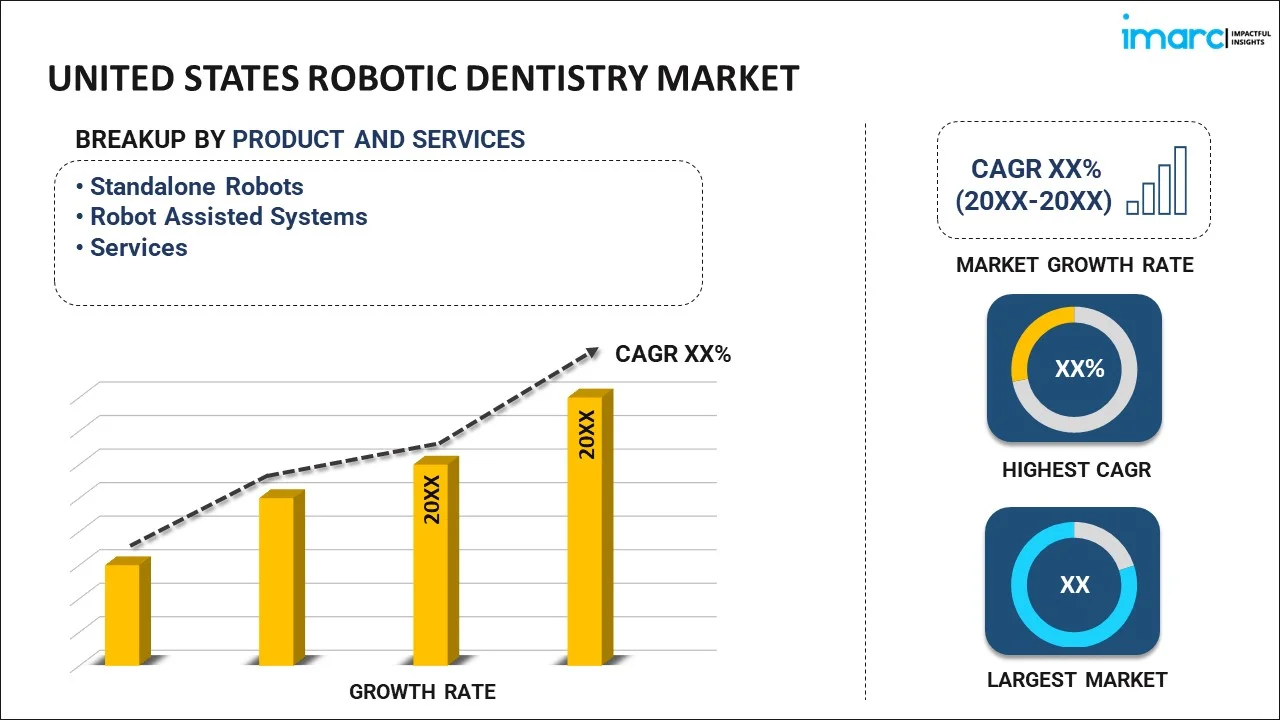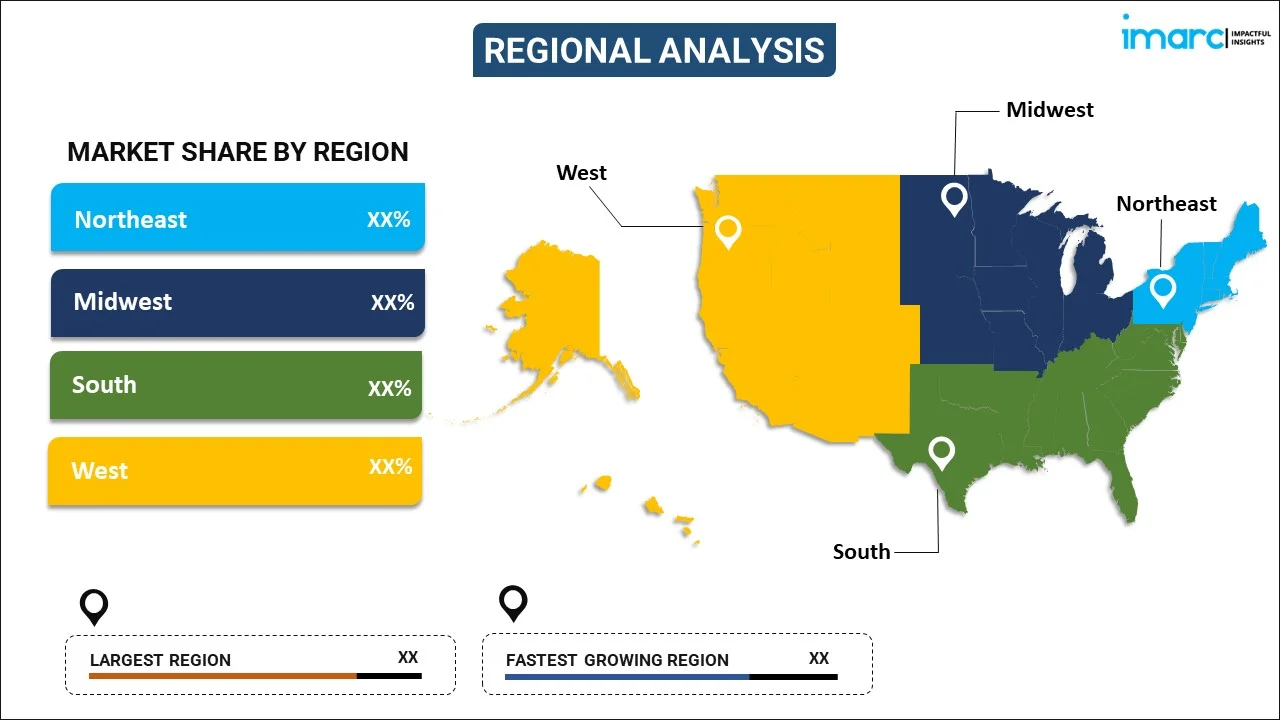
United States Robotic Dentistry Market Report by Product and Services (Standalone Robots, Robot Assisted Systems, Services), Application (Implantology, Endodontics, and Others), End Use (Dental Hospitals and Clinics, Dental Academics, and Others), and Region 2025-2033
Market Overview:
United States robotic dentistry market size is projected to exhibit a growth rate (CAGR) of 13.7% during 2025-2033. The increasing adoption of robotics, which can enable smaller incisions, faster recovery times, and less post-operative pain, making it an attractive option for both patients and practitioners, is primarily driving the regional market.
|
Report Attribute
|
Key Statistics
|
|---|---|
|
Base Year
|
2024 |
|
Forecast Years
|
2025-2033
|
|
Historical Years
|
2019-2024
|
| Market Growth Rate (2025-2033) | 13.7% |
Robotic dentistry involves the integration of robotic technology into dental procedures, revolutionizing the field by enhancing precision and efficiency. These advanced robotic systems aid dentists in tasks such as tooth preparations, surgeries, and diagnostics. Equipped with intricate sensors and software, they offer real-time feedback, ensuring optimal outcomes. Robotic dentistry minimizes human error, leading to improved accuracy in procedures like implant placements and complex surgeries. Additionally, these systems can streamline repetitive tasks, reducing procedural time and enhancing patient comfort. While still evolving, the potential of robotic dentistry lies in its ability to augment the skills of dental professionals, ultimately advancing the quality of dental care by combining human expertise with cutting-edge technology.
United States Robotic Dentistry Market Trends:
The robotic dentistry market in the United States has emerged as a transformative force in the dental industry. Notably, the market is being propelled by a confluence of factors, beginning with the rising demand for precision and efficiency in dental procedures. To meet this demand, robotic dentistry offers unparalleled accuracy and consistency, ensuring optimal outcomes for patients. Furthermore, the increasing prevalence of dental disorders regionally has intensified the need for innovative solutions, and robotic dentistry stands at the forefront. This technology addresses the limitations of traditional dental procedures by minimizing human errors and enhancing procedural efficacy. In addition, the aging population contributes significantly to the market's growth, as older individuals often require complex dental interventions that can be seamlessly facilitated by robotic systems. The integration of artificial intelligence (AI) and machine learning into robotic dentistry systems serves as another pivotal driver. This synergy empowers robots to analyze vast amounts of data, refine their techniques over time, and customize treatment plans based on individual patient characteristics. The growing acceptance of teledentistry and remote consultations further accentuates the relevance of robotic dentistry, underscoring its potential to revolutionize oral healthcare delivery. Consequently, the robotic dentistry market in the United States is witnessing a robust surge, driven by a harmonious interplay of technological innovations, demographic trends, and evolving healthcare practices.
United States Robotic Dentistry Market Segmentation:
IMARC Group provides an analysis of the key trends in each segment of the market, along with forecasts at the country level for 2025-2033. Our report has categorized the market based on product and services, application, and end use.
Product and Services Insights:

- Standalone Robots
- Robot Assisted Systems
- Services
The report has provided a detailed breakup and analysis of the market based on the product and services. This includes standalone robots, robot assisted systems, and services.
Application Insights:
- Implantology
- Endodontics
- Others
A detailed breakup and analysis of the market based on the application have also been provided in the report. This includes implantology, endodontics, and others.
End Use Insights:
- Dental Hospitals and Clinics
- Dental Academics
- Others
The report has provided a detailed breakup and analysis of the market based on the end use. This includes dental hospitals and clinics, dental academics, and others.
Regional Insights:

- Northeast
- Midwest
- South
- West
The report has also provided a comprehensive analysis of all the major regional markets, which include Northeast, Midwest, South, and West.
Competitive Landscape:
The market research report has also provided a comprehensive analysis of the competitive landscape in the market. Competitive analysis such as market structure, key player positioning, top winning strategies, competitive dashboard, and company evaluation quadrant has been covered in the report. Also, detailed profiles of all major companies have been provided.
United States Robotic Dentistry Market Report Coverage:
| Report Features | Details |
|---|---|
| Base Year of the Analysis | 2024 |
| Historical Period | 2019-2024 |
| Forecast Period | 2025-2033 |
| Units | Million USD |
| Scope of the Report | Exploration of Historical Trends and Market Outlook, Industry Catalysts and Challenges, Segment-Wise Historical and Future Market Assessment:
|
| Product and Services Covered | Standalone Robots, Robot Assisted Systems, Services |
| Applications Covered | Implantology, Endodontics, Others |
| End Uses Covered | Dental Hospitals and Clinics, Dental Academics, Others |
| Regions Covered | Northeast, Midwest, South, West |
| Customization Scope | 10% Free Customization |
| Post-Sale Analyst Support | 10-12 Weeks |
| Delivery Format | PDF and Excel through Email (We can also provide the editable version of the report in PPT/Word format on special request) |
Key Questions Answered in This Report:
- How has the United States robotic dentistry market performed so far and how will it perform in the coming years?
- What has been the impact of COVID-19 on the United States robotic dentistry market?
- What is the breakup of the United States robotic dentistry market on the basis of product and services?
- What is the breakup of the United States robotic dentistry market on the basis of application?
- What is the breakup of the United States robotic dentistry market on the basis of end use?
- What are the various stages in the value chain of the United States robotic dentistry market?
- What are the key driving factors and challenges in the United States robotic dentistry?
- What is the structure of the United States robotic dentistry market and who are the key players?
- What is the degree of competition in the United States robotic dentistry market?
Key Benefits for Stakeholders:
- IMARC’s industry report offers a comprehensive quantitative analysis of various market segments, historical and current market trends, market forecasts, and dynamics of the United States robotic dentistry market from 2019-2033.
- The research report provides the latest information on the market drivers, challenges, and opportunities in the United States robotic dentistry market.
- Porter's five forces analysis assist stakeholders in assessing the impact of new entrants, competitive rivalry, supplier power, buyer power, and the threat of substitution. It helps stakeholders to analyze the level of competition within the United States robotic dentistry industry and its attractiveness.
- Competitive landscape allows stakeholders to understand their competitive environment and provides an insight into the current positions of key players in the market.
Need more help?
- Speak to our experienced analysts for insights on the current market scenarios.
- Include additional segments and countries to customize the report as per your requirement.
- Gain an unparalleled competitive advantage in your domain by understanding how to utilize the report and positively impacting your operations and revenue.
- For further assistance, please connect with our analysts.
 Inquire Before Buying
Inquire Before Buying
 Speak to an Analyst
Speak to an Analyst
 Request Brochure
Request Brochure
 Request Customization
Request Customization




.webp)




.webp)












